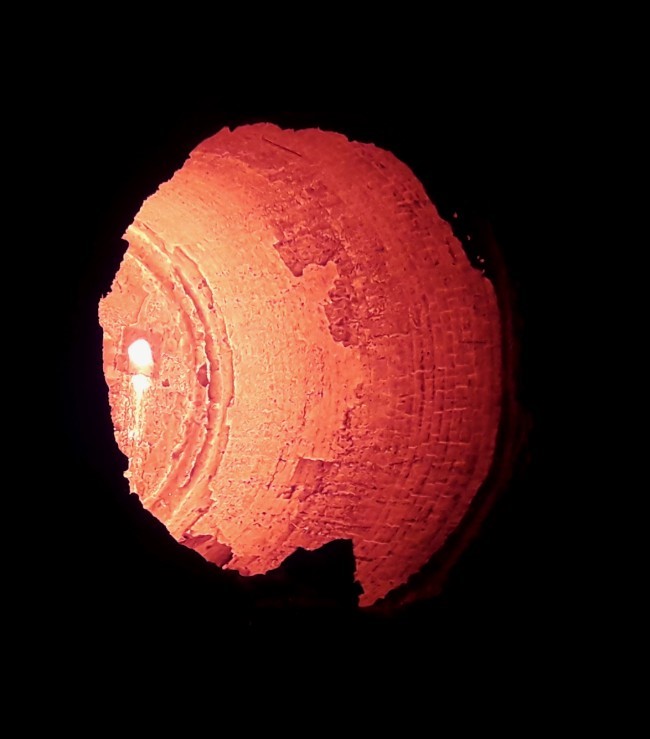Ladle working lining should remain inert to the steel apart from rendering special functions like prevention of breakouts, containment of heat etc.
Thermal
Peak Temperature: Being in direct contact with steel, the temperature of the lining rises to that of the steel. High temperature resistant materials (high m.p) are to be employed.
Thermal Shock: The thermal cycling for the working lining is considerably high and it experiences shock during the tapping of every heat. Thus it ultimately depends on the number of heats per day (Although the number of heats per day varies from 4 to more than 6 in certain shops).
Mechanical
Impact: The impact from the steel is less but depending on the design of BOF and ladle the impact of the tapping stream on the sidewalls can be severe. However, it depends on the angle, the height of impact and the duration of impact(which is dependent on the time to form a pool which can act as for the impact).
Abrasion:The abrasion of the barrel area is dependent on the operation practices. The bath movement being the critical factor for the wear of the refractory. The bath movement is mostly dominated by the purging through the bottom porous plug which is responsible for the wear of the bottom whereas vigorous purging brings turbulence in the bath level which wears the lining.
Applied stress:The height of lining depends on the capacity of the ladle and it varies from shop to shop. The height is responsible for the vertical stress on the lining. Especially when monolithic material, expansion tolerance is to be provided or flexible material is to be used. Flexible material or expansion allowance is to be provided for Alumina-magnesia-carbon brick (AMC) or dolomite bricks owing to their high expansion rate.
Chemical
Dissolution:Wear by dissolution depends on the chemical compatibility of the slags with bricks. Due to the basic nature of the slag basic material are compatible. Basic brick can be used but the bottom material can be used to react with slag to form a protective layer by reacting with slag. High Alumina or alumina spinel is the preferred choice.
Penetration:Penetration is caused by low viscosity metal/ slag or highly wetting metal/slag penetrating into porous refractories which can be a problem for the working lining of a barrel area. This is a problem for non carbon containing brick like alumina where penetration can be even deeper.
Thermo- Mechanical
Strain of thermal expansion-The height of lining depends on the capacity of the ladle and it varies from shop to shop. The height is responsible for the vertical stress on the lining. Especially when monolithic material, expansion tolerance is to be provided or flexible material is to be used. Flexible material or expansion allowance is to be provided for Alumina-magnesia-carbon brick (AMC) or dolomite bricks owing to their high expansion rate.
Chemical Mechanical and thermo mechanical chemical
Spalling of the penetrated zones-This is one of the key wear mechanism. The cumulative effect of applied stress along with due to expansion, thermal cycling and penetration causes spalling of the penetrated zones.
Choice of material
The current practice is the use of monolithic material made from high alumina spinel or magnesia based materials. But bricks of 150-200 mm thick of either alumina(> 75%) alumina-magnesia-carbon or dolomite or magnesia carbon(MgO-C). Although this depends on the grades of steel and the chemistry of the slag used. But the use of AMC brick has been the best balance between cost and performance. For ultra clean steel dolomite or MC material is preferred. A dry vibratable layer can also be used as a expansion layer but have to be replaced after every lining and calls for high cost.
Prevention of ladle breakouts from the barrel area
· Controlling the process and matching the brick quality to prevent aggressive slag attack.
· Lowering thermal cycling to prevent opening up of joints to keep the temperature drop as low as possible.
· Better brick quality is to be ensured.
· Safety lining brick lining quality plays a role in preventing steel penetration. Monolithic safety lining can act as a barrier in stopping/freezing steel/slag.
· Minimum thickness of the safety lining is to be ensured. Correct repair methodology is to be implemented.
· Better and periodical visual inspection through laser and thermographic study by trained and experienced operators helps in prevention of breakouts.



